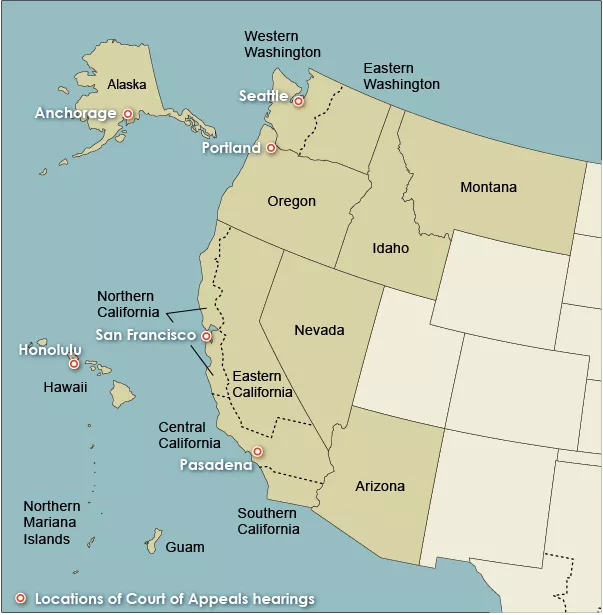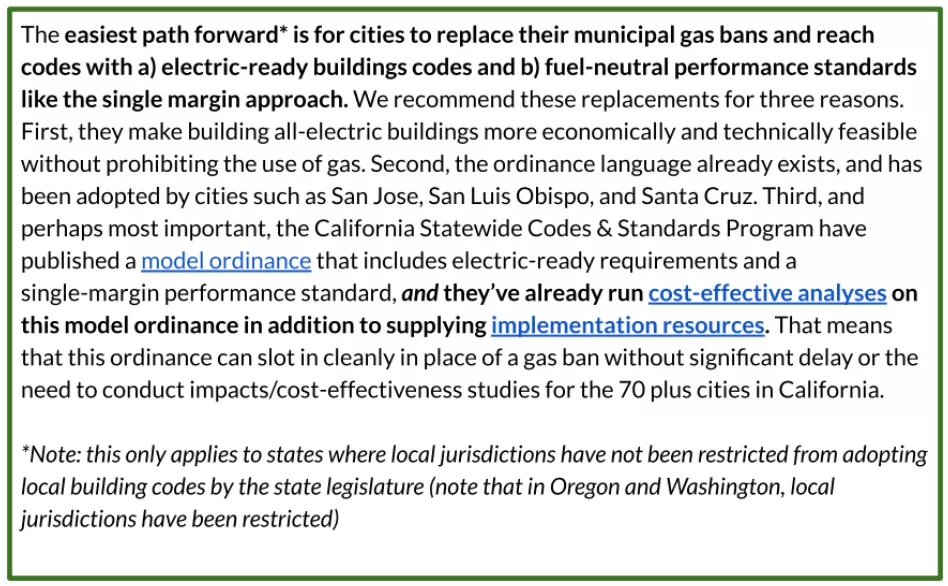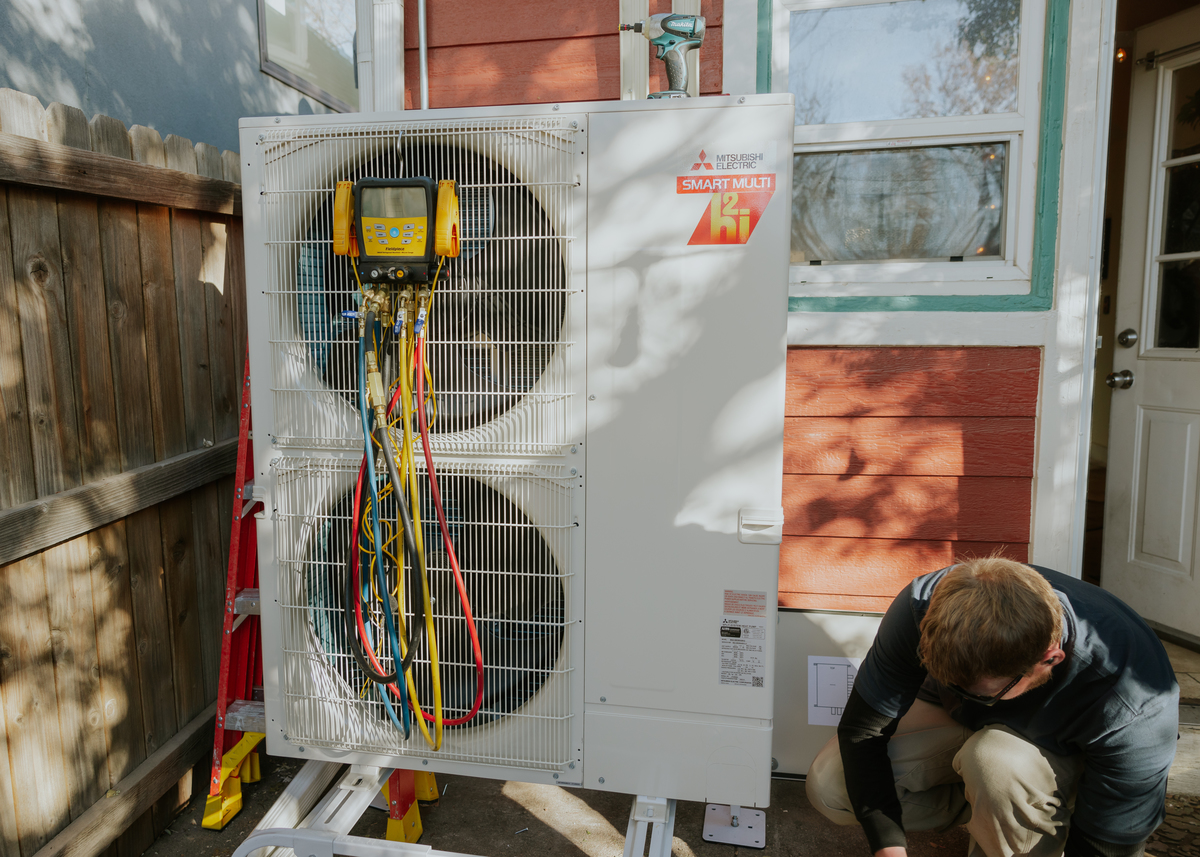In January 2024, the U.S. Court of Appeals for the Ninth Circuit finalized its decision in California Restaurant Association v. City of Berkeley, overturning Berkeley’s historic prohibition on gas piping in new city buildings. Since that decision, climate advocates and local governments have been left with an array of questions: Where does the decision apply? What, exactly, has been banned? What options do local governments have to address the public health and climate pollution that comes from gas use?
Understanding the answers to these questions is critical as we continue to advocate for healthier, more sustainable communities. So let’s dig in.
Where does the Berkeley decision apply?
Within the jurisdiction of the Ninth Circuit Court of Appeals. This includes California, Washington, Oregon, Nevada, Arizona, Idaho, Montana, Alaska, and Hawaii.

What did the Berkeley decision decide?
The Ninth Circuit considered whether the Energy Policy and Conservation Act (EPCA), a federal law, preempted a law in Berkeley that prohibited natural gas piping in new construction from the point of delivery at a gas meter. The court construed Berkeley’s law as prohibiting the operation of gas appliances in new construction, because those appliances could not access the gas utility’s distribution lines. Under EPCA, the federal government can set efficiency standards, including for gas appliances, and once those standards are set, local governments may not impose more stringent requirements. In Berkeley, the Ninth Circuit decided that because the federal government had set efficiency standards for gas appliances, Berkeley was preempted from imposing a ban on those appliances.
In the Ninth Circuit, what is preempted under the Berkeley decision?
State or local regulation within the Ninth Circuit’s jurisdiction that effectively prohibits the use of gas equipment in buildings could be preempted under the decision. This could include any form of all-electric construction requirement (whether it’s framed as a health and safety ordinance, a reach code, etc.) and any prohibition on gas piping in buildings.
Are gas bans federally preempted outside of Ninth Circuit states
No! The Berkeley ruling does not apply outside the Ninth Circuit. However, over 20 states, for example Arizona, Alabama, and Ohio, have state legislative preemption, meaning that these states have passed laws preventing local municipalities from banning gas in new buildings, so it's important to research your specific state.
In the Ninth Circuit, what is not preempted under the Berkeley decision?
The panel declared: “[o]ur holding here is limited. We conclude only that EPCA [Energy Policy and Conservation Act] applies to building codes and that Berkeley’s Ordinance falls within the Act’s preemptive scope" and "our holding here has nothing to say about a State or local government regulation of a utility's distribution of natural gas… ."
There is a whole suite of electrification policies that are not preempted under the Berkeley decision, including policies that encourage, but do not require, electrification. That area includes regulations that promote electrification or restrict gas distribution, such as: a) electric-preferred ordinances, b) building codes that make electrification economically favorable but do not require it (including fuel-neutral “single-margin” codes), and c) building performance standards with flexible compliance options that can be met with gas equipment are also not preempted. Utility regulations on gas distribution apply upstream of the customer meter and therefore are not preempted. Incentives for electrification are not preempted. Last, zero-emissions standards that are enacted by the state air agencies (or, in some states, local air districts) tasked with implementing the federal Clean Air Act are not preempted (more on this below).
Within the Ninth Circuit, what can cities do post-Berkeley?
- Ensuring All-Electric New Construction
Electric-ready + single-margin building codes

- Low-NOx and Ultra Low-NOx Health and Safety Regulations
Municipalities may pass low-NOx and ultra low-NOx emissions limits on new buildings. These limits do not prohibit gas use but make it much easier to comply by just building all-electric.
- Facilitating Retrofitting of Existing Buildings
- Franchise Agreements
A franchise agreement is a negotiated contract between a municipality and a utility that grants the utility the right to serve customers in the city's jurisdiction.
Some cities have incorporated energy objectives into franchise agreements—or have signed agreements in parallel—that commit the city and utility to work together to achieve joint energy goals. Electrification can be one of those goals, especially when dealing with a dual-fuel utility. In cities like Eugene and Gresham in Oregon, municipalities have replaced franchise agreements with what are called “right of way” ordinances, which allow cities to unilaterally set fees on utilities, revenue which can then be used to support electrification.
- Tenant Protections
Appliance regulations such as BAAQMD and CARB’s that restrict the sale of gas appliances by a certain date (and therefore require replacement with electric appliances) will be most successful if tenants are protected from rent hikes associated with these replacements/upgrades. Municipalities have unique power to protect tenants from rent hikes, eviction, and displacement justified by building electrification. Organizations such as SAJE in Los Angeles and Climate and Community Project nationally have published policy recommendations for protecting tenants through the energy transition.
- Funding Electrification
A straightforward way for municipalities to put their thumb on the scale in favor of electrification is by funding electric appliances, weatherization, and electrical infrastructure upgrades, especially in low-income communities (See, for example, the City of Portland’s Clean Energy Fund). Such funding will make compliance with zero-NOx regulations more facile and will also ready the market (contractors and suppliers) for more widespread electrification while educating customers on electrification in advance of implementation of air district regulations.
Cities have also been putting together “navigator” websites to assist folks in accessing electrification incentives already available from their local utilities, the state, or federal government. This can be a good option for a city with less resources to directly fund electrification programs. One example of a navigator website is The Switch is On, in which a person can enter their zip code and find available rebates.
- Federal Grant Applications
Similarly, municipalities can further electrification by applying for funding through federal programs that fund equitable electrification projects. Environmental justice block grants available through the Inflation Reduction Act can fund direct install electrification projects in environmental justice communities. Here you can find information about the programs local leaders can apply to that will help cities and counties reach their climate goals.
- Self Regulation (for larger cities/counties)
Larger municipalities can prime the market for electrification and prove out the economic benefits of electrification by passing restrictions on their own use of gas in their facilities and buildings.
Municipalities can pass bans on the procurement of gas appliances for their buildings and facilities, thereby requiring the retrofitting of these buildings with electric appliances once the gas appliances burn out.
Municipalities may also proactively initiate projects to electrify their own buildings and facilities before gas appliance burnout. They can take advantage of federal and state funding for electrification of community centers, schools, hospitals, and other municipally-owned facilities.
- Energy Efficiency Renovation Policy
Adopting energy efficient renovation policies for major residential additions and alterations can facilitate electric retrofitting of existing buildings. The City of San Luis Obispo, City of Piedmont, and Marin County have passed similar ordinances.
- Air Conditioner to Heat Pump
A low-hanging fruit existing buildings policy is prescriptively requiring installation of two-way heat pumps when replacing broken air conditioning (AC) units. Avoiding the installation of one-way ACs today will save families money and hassle down the road, as the California Air Resource Board (CARB) and other air districts move toward zero-emissions appliances standards as early as 2030. These zero-emissions standards will require heat pumps to be installed instead of polluting gas furnaces; with an AC-Heat Pump replacement policy, customers facing gas furnace burnout will save thousands of dollars, as they will have already replaced their AC with a heat pump.
- Franchise Agreements
Why are CARB and Air District zero-emission standards not preempted?
Because the federal Clean Air Act is based on cooperation between states and EPA, these standards are part of the federal air quality regulatory scheme. While EPCA, the federal statute at issue in Berkeley, preempts state and local law, it must be harmonized with other federal law including the Clean Air Act. CARB and Air Districts’ zero-emission equipment standards’ status under the federal Clean Air Act, codified by their insertion into the State Implementation Plan, insulate them from EPCA preemption. Moreover, CARB and the Air Districts have been regulating NOx for years, without challenge, and the zero-NOx standards are a natural next step in their attempts to achieve attainment of federal air quality standards.
Conclusion
While the Ninth Circuit’s decision to overturn Berkeley’s efforts to clean up buildings in the city was a blow, the ruling was somewhat narrow in scope and does not take away many tools still available to states and cities to electrify buildings to reach net-zero goals. Done the right way, governments can still achieve all-electric buildings that reject the polluting and dangerous practice of burning fossil fuels under our roofs.
